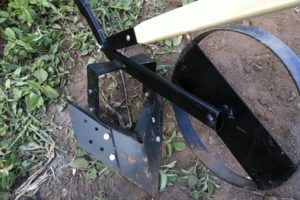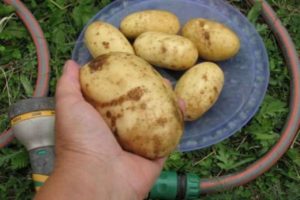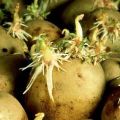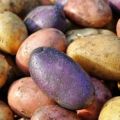Description of the Riviera potato variety, agricultural technology and growing rules
Riviera potatoes were obtained by crossing the famous Dutch varieties - Minerva and Alcmaria. The "Agrico" holding is considered a patented seed producer. Since 2013, the variety was included in the State Register and began to be cultivated in Russia. Due to its positive qualities, the culture has gained great popularity not only in the southern regions, but also in such regions as the Moscow region, Siberia, and the North Caucasus.
Content
Description of the variety
The Riviera potato variety belongs to ultra-early, high-yielding tuber crops. The first ripening of fruits begins 40 days after germination of the shoots. Mass collection and full return of the crop occurs 80 days after planting. According to the recorded data, the total yield of the variety is more than 300 kg from 100 sq. m.
Detailed description of the variety:
- Plant. The Riviera bush is quite tall, its height reaches 1 meter. The plant is erect, with strong stems. The leaves are large, rich green, wavy on the sides. During the growing season, red-purple flowers are formed on the brush. The root system is powerful and well developed.
- Tubers. The Riviera potato has an attractive oval shape. The skin is slightly rough, dense, light yellow in color. The eyes are shallow. The fruits are even. The pulp is granular, beige. On average, 15 fruits are formed in 1 hole, the weight of which varies from 100 to 170 g.
Pay attention! If the Riviera variety is grown in greenhouse conditions, it will be possible to harvest 2 crops in one season.
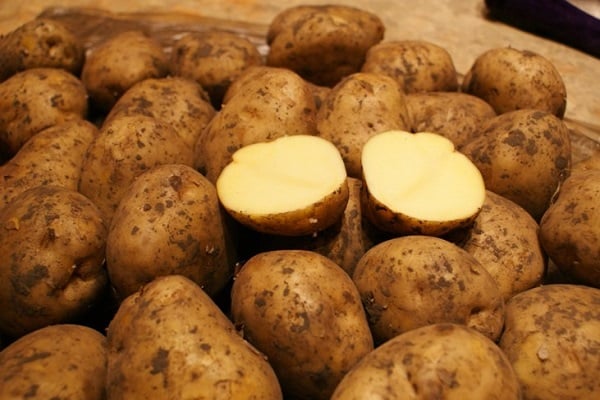
Fruit characteristics
Almost all tubers of Riviera potatoes have an attractive presentation, which at the exit is from 85 to 95%.
Consumer characteristics of tubers:
- taste - 4.8 on a 5-point scale;
- starch content - 12-18%;
- dry matter content - 18.7%;
- appointment - dining room.
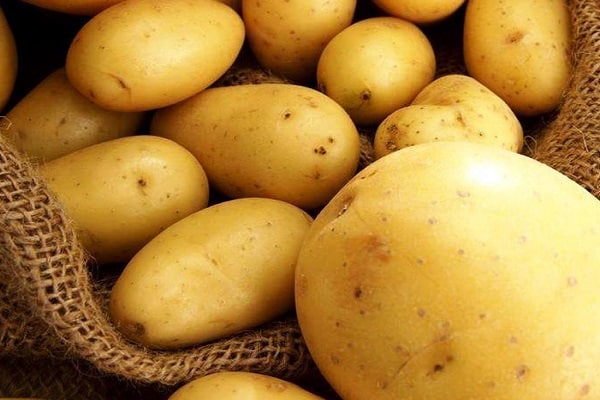
The peculiarities of the Riviera variety are that its fruits are endowed with high resistance to mechanical damage. During long-distance transportation, the potatoes remain intact without the blackening of the pulp. If the temperature regime is +4 degrees, the keeping quality of potatoes is 94%.
Advantages and disadvantages of the variety
Like any fruit crop, the Riviera potato has its advantages and disadvantages. Consider all the qualities of the variety that can affect the choice.
Pros of the variety:
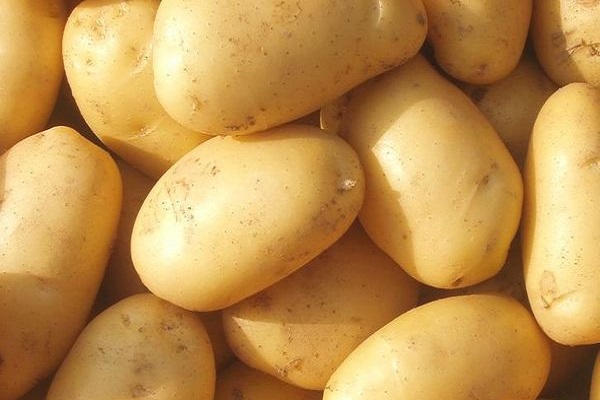
- high and early yield;
- good consumer qualities;
- long shelf life;
- good transportation;
- immunity to potato cancer;
- resistance to many viral and fungal infections.
The advantages of the variety also include good drought resistance. Even with a fairly dry summer, Riviera potatoes give high yields.
The variety does not have any particular drawbacks, the only drawback is its poor resistance to late blight.
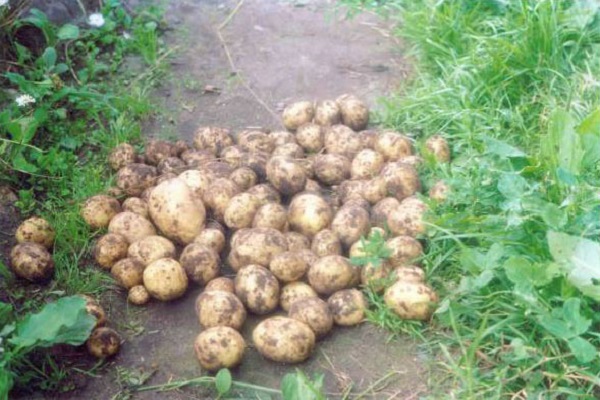
Agrotechnics and rules for growing varieties
To shorten the growing season without losing the quality and quantity of yield, when growing the Riviera variety, you will need to perform certain agricultural techniques. In fact, it is not as difficult as it might seem at first glance. To complete it, it will be enough to follow the sequence below.

Selection and storage of planting material
As the reviews of gardeners have shown, it is better to select planting material immediately after harvesting. For this, healthy, undamaged fruits weighing 40 to 70 g are selected from all tubers.
Important: Many novice gardeners believe that the greater the weight of the planting material, the higher the yield at exit. In fact, this opinion is erroneous. In one bush from a large potato, 2 times less fruits are formed than from an average tuber.
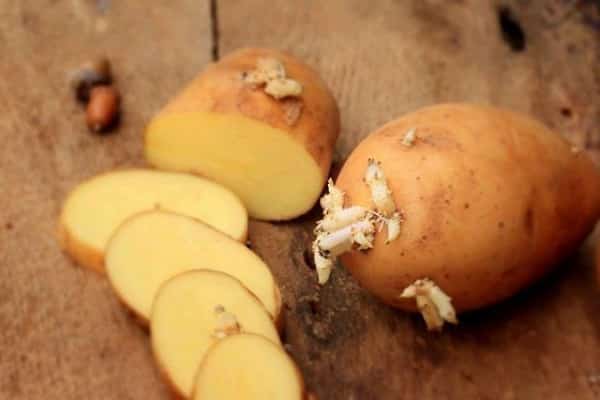
After collecting selected planting material, he is given time for 2 weeks to lie down in a well-ventilated and well-lit place. In this case, the peel of the potato will harden well before storage, and minor scratches will heal. Further, the tubers are moved to the cellar until spring. The optimum temperature for storing planting material is considered to be + 2–4 degrees, air humidity - 70%.
Tuber preparation
1.5 months before the expected planting potato tubers taken out of the cellar. Planting material gets over from rotten and damaged fruits. Then the selected potatoes undergo sprouting and pickling.

Tuber germination methods:
- Light germination. This method is considered the most common. When using it, it will be enough to spread the tubers in a well-lit place and maintain an optimal temperature of 20 degrees. At the same time, it is recommended to periodically turn the potatoes over the course of a month, creating uniform illumination for them.
- Mini greenhouse germination. For this method, plastic bags are used, in which holes of up to 10 pieces are made. Then up to 10 potato tubers are placed in them. Seed bags are tied and hung from the ceiling of a bright room. At the same time, you need to choose a place so that direct sunlight does not fall on it.
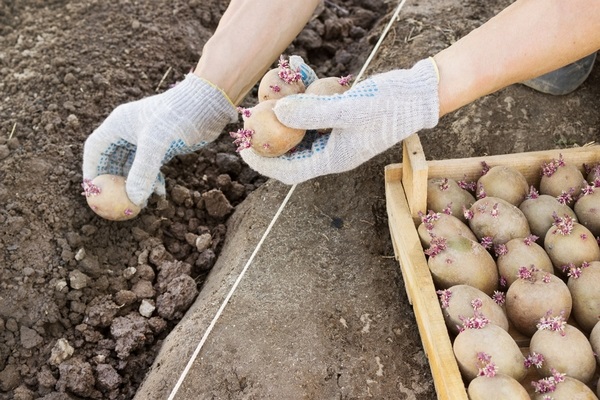
When sprouts appear on the tubers, and they are ready for planting, it is recommended to pickle them against various diseases. To do this, first, the potatoes are sprayed with water, and after a day they are treated with a disinfecting solution consisting of water, formalin and vitriol.
Site preparation for planting
The highest Riviera harvest rates were recorded when potatoes were grown in fertile, light soil... It is desirable that the area with such soil be well lit from all sides and protected from the north wind.
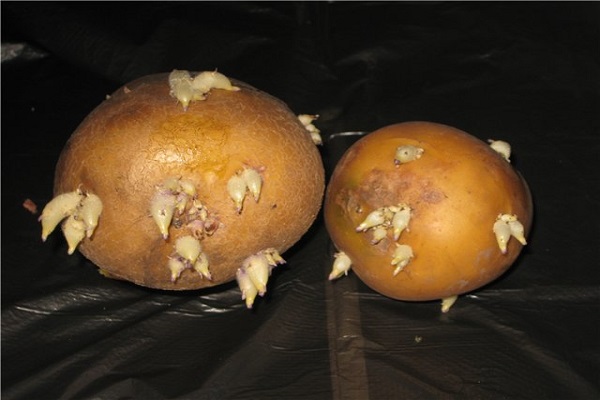
Before planting, it is recommended to dig the selected area well, while removing all weeds and their rhizomes. It is advisable to add organic matter to the prepared soil. Rotted manure is considered the best fertilizer.
Tuber planting rules
When the regular air temperature reaches 20 degrees, and the soil at a depth of 10 cm warms up to 10-15 degrees, you can start planting tubers. Today there are several methods of planting potatoes. Reviews of gardeners indicate that it is rational to use the traditional method. This is justified by the fact that it is simpler and does not take up a lot of free time, which is so convenient if the dacha is located far from home.
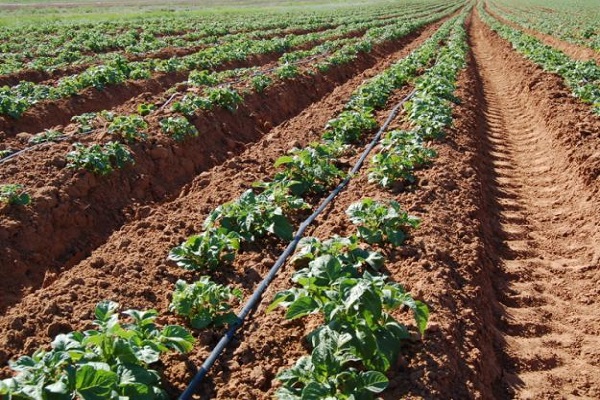
Description of planting potatoes Riviera:
- In the area from north to south, ridges are formed, with a consistent distance from each other of 70 cm.
- Every 30 cm, holes are dug on the ridges, about 10 cm deep.
- One handful of ash is added to each pit.
- One potato tuber is placed in the hole and covered with soil.
After planting, the soil in the beds must be leveled with a rake.

Agrotechnics after planting
Riviera potatoes do not require special care during growth. But nevertheless, a competent approach will have a positive effect on the quality of the crop.
Basic care includes:
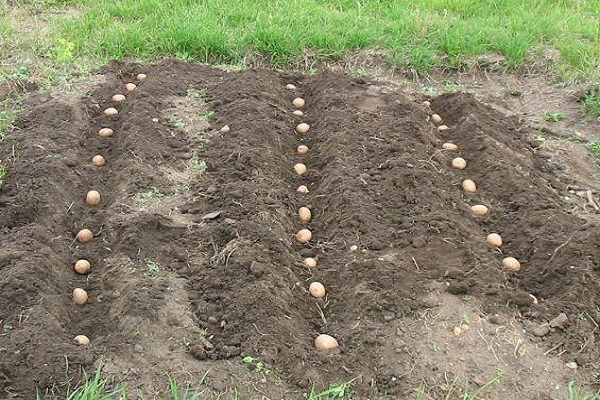
- Watering. The Riviera variety is undemanding to frequent watering; irrigation will be sufficient only during a long drought.
- Loosening. This shallow tillage is recommended during dry periods or during prolonged rains.
- Hilling. This procedure stimulates the growth and development of tubers. It is held twice. The first hilling is carried out when the height of the bush reaches 15 cm, the second - with an interval of 3 weeks.
- Top dressing. The Riviera responds well to complex fertilizers. Mineral and nitrogen fertilizing, as a rule, is applied during hilling of bushes.
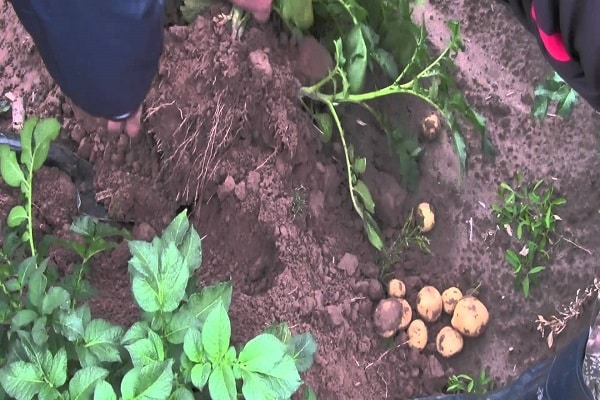
During growing potatoes do not forget about pest control. At the first signs of the appearance of insects, potato bushes must be treated with special chemicals.
Despite the fact that the Riviera potato variety appeared in Russia not so long ago, it has already gained great popularity among gardeners. Early yield and taste of beautiful fruits will please any gourmet. And simplicity in agricultural technology will allow even lazy summer residents to breed a variety.

